Psychological intervention in prison according to the integrated Gestalt approach: relational aspect and risonances
Published 2020-09-23 — Updated on 2022-06-16
Versions
- 2022-06-16 (2)
- 2020-09-23 (1)
Keywords
- context penitentiary,
- prisoners treatment,
- prison psychologist,
- methodology gestaltic integrated
How to Cite
Copyright (c) 2020 Valentina Maltese, Sebastiana Cipponeri, Salvatore Renda

This work is licensed under a Creative Commons Attribution-NonCommercial 4.0 International License.
Abstract
This work was born with the aim of creating an integrated methodology of psychological intervention in the penitentiary context. In this sense, has been created a path-intervention-treatment that combines the gestalt principles of attention to the present, responsibility and awareness with a Rogersian approach of unconditional acceptance and absence of judgment to allow through the narration of oneself a re-signification of one's own path of life with a view to change. This approach has as a parallel purpose that of improving the psychological condition of the prisoner, who lives in a relational dimension perpetually characterized by the conflict between different "actors" and in a temporary dimension that fluctuates from past to future, with the impossibility to reflect on the here and now. The work aims to outline a path-intervention through an integrated approach that aims to individualize the treatment pathway in a specific way and to outline a methodology of intervention for the prison psychologist, which allows to effectively facilitate a possible critical review of the crime, through the stimulation of self-awareness and self-harm and a consequent improvement in the psychological well-being perceived by the inmate himself. For the evaluation of the effectiveness of the treatment, a self report instrument was built in order to identify the presence of anxious depressive symptoms in the prisoner, before and after the psychological intervention performed.

